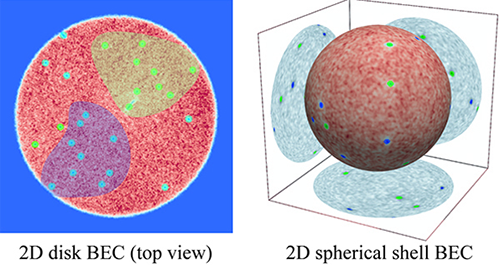| Sep 22, 2021 |
Engineering researchers develop new explanation for formation of vortices in 2D superfluid
(Nanowerk News) Researchers at the FAMU-FSU College of Engineering and the National High Magnetic Field Laboratory have new insight about the formation of vortices in a type of quantum fluid, work that could help our comprehension of the physics mystery of how vortex clusters form and provide valuable understanding into the atmospheric swirling motion on planets such as Earth and Jupiter.
|
|
The researchers revealed an alternative explanation for the formation of so-called Onsager vortices in a two-dimensional superfluid, a type of quantum fluid that can flow without friction. Their findings were published in Physical Review Letters ("True Mechanism of Spontaneous Order from Turbulence in Two-Dimensional Superfluid Manifolds").
|
 |
| Illustrations showing the spontaneous appearance of large-scale Onsager vortices in a 2D disk Bose-Einstein Condensate (shaded regions) in contrast with the non-existence of the Onsager vortices in the 2D spherical shell Bose-Einstein Condensate. (Image: Wei Guo/FAMU-FSU College of Engineering)
|
|
“This finding gives us a new explanation for how these vortices might form and is an important step toward continuing to improve our understanding of quantum physics,” said Wei Guo, associate professor in mechanical engineering and lead investigator of the study.
|
|
In 1949, Nobel Laureate Lars Onsager proposed a simple theory relating to our understanding of the swirling motion in turbulent 2D fluids, which are fluids constrained to move in a two-dimensional space.
|
|
Onsager’s theory says when energy is added constantly into a 2D turbulent fluid with chaotic small swirls (formally called vortices), those swirls rotating in the same direction would cluster to form large-scale persistent swirls when the energy is sufficiently high. These clusters or large-scale swirls are known as “Onsager vortices.” Jupiter’s Great Red Spot is a good example.
|
|
“Onsager’s theory requires energy to be added to the 2D fluid,” Guo said. “However, recent publications revealed that in 2D Bose-Einstein Condensates (BECs), Onsager vortices can appear spontaneously without energy input. We set out to do more investigations into these surprising results.”
|
|
BEC is a state of matter where identical atoms or molecules are confined by a laser or magnetic trap and cooled to near absolute zero. The particles in the BEC state occupy the same quantum mechanical energy level and can exhibit superfluid behaviors, such as flowing without the apparent loss of kinetic energy and rotating around tiny hollow tubes called vortex tubes. With an appropriate trap, a BEC can be confined to have a quasi-2D disk shape, that is, a shape with a small thickness but a large radius. The vortex tubes in a 2D BEC appear like tiny point swirls, which can serve as an ideal testbed for Onsager’s theory.
|
|
“A well-accepted explanation of the spontaneous appearance of Onsager vortices in 2D disk BECs is the evaporative heating mechanism,” Guo said. “This mechanism refers to what physicists call vortex annihilation, which is when a pair of vortices with opposite rotations merge and disappear, just like a positive charge neutralizes with a negative charge.”
|
|
“As the vortices annihilate, the energy per vortex increases, which leads to the formation of Onsager vortices,” said Toshiaki Kanai, a graduate research student working with Guo at the National High Magnetic Field Laboratory.
|
|
However, in a numerical simulation performed by Kanai and Guo while studying the turbulent swirling motion in 2D, with BECs confined on the surface of a sphere, they found that Onsager vortices never formed despite the annihilations of the vortex pairs. The researchers then conducted a comparative study of the vortex dynamics in both disk BECs and spherical shell BECs.
|
|
“We finally figured out that the spontaneous formation of Onsager vortices is not due to the well-accepted evaporative heating mechanism,” Guo said. “The true mechanism is the exiting of the vortices from the 2D BEC boundary.”
|
|
The disk BEC has a circumference where the vortices can exit, while the spherical shell BEC does not have any boundaries. Therefore, Onsager vortices are observed only in the disk BECs but not in the spherical BEC shells, according to the researchers.
|
|
“Identifying the true mechanism for the spontaneous formation of Onsager vortices in 2D BECs represents a major progress in our understanding of 2D superfluid turbulence,” Guo said. “Our findings about the point vortices on a sphere may represent a conceptually interesting model of a planetary atmosphere, and these findings can be tested experimentally at NASA’s space laboratory.”
|
|
NASA has recently installed a cold atom laboratory at the International Space Station, which has made it feasible to produce BECs in spherical shell geometry. Future experimental studies in zero gravity could help advance the science in this field.
|

